Choosing eating and drinking equipment
Factsheet Contents
DOWNLOAD FACTSHEET- Disclaimer
- Introduction
- Assessing your needs
- Provision of eating and drinking equipment
- Identifying your difficulties
- Protecting your clothing – bibs and aprons
- Drinking Equipment
- Cutlery
- Plates, bowls and trays
- Eating systems
- References
Disclaimer
This factsheet is for advice and guidance only. It is not intended to replace advice from a medical professional. Please ensure you follow manufacturer’s instructions for use and that you carry out appropriate risk assessments.
Introduction
Eating and drinking are two activities that you rarely consider in detail, but they are a core part of your everyday living and are often a very important part of social interaction. When they become difficult to do for yourself, the problems can seem to be disproportionately dominant. There are possible solutions for you to consider, but first it is important to consider a number of factors about yourself and the reasons for your difficulties, so that you and/or your carers can make informed decisions and choices.
Assessing your needs
If you have not had an opportunity to discuss your eating and drinking difficulties with a professional, you are strongly advised to seek an assessment of your situation.
Speech and language therapists are experts in the mechanics of eating, drinking and swallowing. They will be able to advise you if you experience physical difficulty in these actions. Your GP can refer you to your local speech and language therapy service, or you may be able to refer yourself.
Occupational therapists can advise on eating and drinking techniques and equipment to overcome practical difficulties. If you are at home and not currently receiving hospital treatment, you will need to contact the local authority occupational therapy service for adults. You may be asked to describe your difficulties so that social services can direct you to the most appropriate service or professional.
If you are struggling with caring for yourself, which includes getting enough to eat and drink, consider asking for a health and social care needs assessment. Since the Care Act 2014 came into power in April 2015, anyone who appears to need care and support can request an assessment from their local council, irrespective of their income or savings. The Act also places a statutory duty on local authorities to assist their residents to prevent a deterioration in their health and well-being. The 'prevention' strategies of many local authorities include the early provision of
equipment and services to help prevent, delay or reduce the development of needs for care and support.
The assessment aims to identify any difficulties you may be having in caring for yourself, and how these may impact upon your well-being. If you have someone who helps you, they can have a carers' assessment to see if they also need support to continue in their caring role.
Provision of eating and drinking equipment
You may be provided with equipment and services as a preventative measure, before a needs assessment is done. If, on assessment, your needs are high enough to qualify for help from the local authority, they will then look at your income and savings to see whether you will need to pay towards any future services you receive. These services might include disability equipment including alarms or telecare, adaptations to your home, help from a carer, or the delivery of meals or residential care.
If you are provided with direct payments or a personal budget from the local authority, you can pay for equipment and other one-off purchases that have been identified as needed in your health and social care assessment.
In many areas, a range of aids to assist with daily living may be available on prescription, issued by an assessor. If you receive a prescription for equipment, you can take it to a local accredited retailer, which may be a local pharmacy, who will provide you with the item. You can pay extra for an alternative item, so long as it does what the specific item prescribed would do. Your choice may offer extra features, or perhaps you prefer its appearance.
If your needs are at a lower level, the local authority must still provide you with information and advice about alternative services or resources which could help you.
Impartial advice
If you decide to buy equipment privately, it is best to try and compare the different ranges first. You may have an equipment demonstration centre near you where you can visit to view and try out different equipment. You will receive impartial advice to help choose appropriately.
Private purchase
A number of high street and web-based retailers now stock a range of eating a drinking equipment. Be cautious of salespeople who try to persuade you to buy equipment that may not meet your needs fully or is over-priced. If you know and understand the difficulties that you have and the reasons for them, you will be more
able to select the right equipment to meet your needs. Look for retailers who are members of the British Healthcare Trades Association (BHTA), which means that they adhere to the organisation’s code of practice. You can search the BHTA website for local retailers.
When you are looking at equipment, consider practicalities such as whether the cutlery/crockery can be washed in a dishwasher, whether dishes are suitable for the microwave and whether they are also suitable for a carer to handle, put together, keep clean, etc.
Identifying your difficulties
General advice
Eating and drinking both involve many different decisions, actions and movements. They are complex activities and can be disrupted in many ways. For anyone, whether they have a disability or not, it is best to be sitting upright in a well-supported position. You should be sat close to the table or tray, which should be roughly at the height of your elbow. This means that the table can be used to support your forearms if required.
If the core of your body is stable, upright and well aligned, you are more likely to have better control and movement of the rest of your body. Ideally, you want to be seated with your feet on the floor (or foot plates of a wheelchair, or a footrest), with your ankles, knees and hips at right angles. Your neck should be in line with your body, with your chin slightly tucked in.
Consider the environment that you are eating in. Try to eat in a well-lit area which is clear of clutter and hazards. Ensure floor surfaces are non-slip, easy to mobilise safely on, but also easy to keep clean. Ensure that the chair being used is a suitable height, that it offers adequate support and stability and is easy to keep clean, if required.
Your sight
If your sight is impaired or deteriorating, there are some practical things you can do to help. Often, it is about working with your family and friends, organising yourself and your food and drink, so that there are less ‘unknowns’.
If you have some sight, you can use brightly coloured or contrasting cutlery and dishes. It is advised to avoid using busy patterns in tablecloths or place mats. Try to arrange the food on the plate in the same way each mealtime. You can use a ‘clock face’ system. This means that a particular food type is always in the same place on the plate. For example, potatoes are always at 3 o’clock.
The Royal National Institute of Blind People (RNIB) has some useful information on their website.
Pain and stiffness, or muscle weakness, in your shoulders and neck
If you have pain or stiffness in your neck, perhaps due to arthritis, you may not be able to tilt your head forwards or backwards. If you have muscle weakness for a neurological reason, you may find holding your head upright, or tilting it, more difficult. If you find it difficult to maintain your head in an upright position, try using a head rest, a rolled-up towel or a small cushion as a support.
Look for cups and cutlery which require less movement of the head to enable you to eat and drink. Straws can also be useful.
Your hand grip
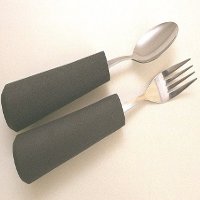
If you find it difficult to grip things, perhaps due to pain or weakness, try looking for cutlery that has a larger handle, without making it too heavy. There are some that are ergonomically shaped, some are padded and some can be moulded to fit your specific grip. Try them out to see which you find most helpful.
Look for mugs or cups with two handles and are not too heavy. There are both cutlery and cups/mugs available with a strap which goes across the back of your hand for additional grip, if required.
Your hand control
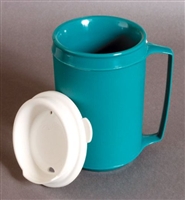
Some people experience an uncontrollable tremor or tremble in parts of their body. This is called an essential tremor. It is often worse when you are concentrating on trying to do a certain activity. There is not always a known cause.
Sometimes using heavier cutlery and cups/mugs can help to reduce, or ‘dampen’, a tremor in the hands. Try using a two-handled cup, or one with a lid, like a travel mug. There are cups with a spouted lid which can prevent spillage, or you might find it easier to use a straw. An overfilled cup will be difficult to manage. Filling to three-quarters depth may be more practical.
There are plates and bowls available with raised rims or in-built sections. These can make it easier to scoop up food. Alternatively, you can use a plate guard which clips onto your plate of choice. Using a dish with a non-slip base or using a non-slip mat can help to keep the dish still.
Loss of sensation in your hands
In addition to having difficulty maintaining a continuous and strong grip on the cup, a person with reduced sensation in their hands may need to observe more closely what they are doing. This is because automatic feedback from receptors in their hands is unreliable. Larger grips on cutlery and cups may be helpful. Also consider the use of insulated mugs.
The use of one hand only
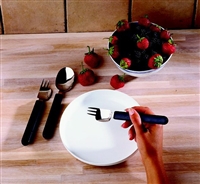
Using cutlery is usually a two-handed task. The food is secured by a fork in one hand, whilst the other hand uses a knife to cut the food. There are some cutlery designs available that combine functions. For example, a fork with a cutting edge. There are also knives which you rock across the food to cut it up. Using a dish with a raised rim, or a clip-on plate guard can help if a scooping motion is used to pick up food.
Adapted cutlery and crockery are described in more detail later in this factsheet.
Difficulty controlling the amount of liquid transferred to your mouth
There may be difficulty controlling the angle that the cup is tipped at, resulting in too much liquid being dispensed. Weakness in the muscles of the lips and mouth may also impact on being able to make an effective seal around a spout when the cup is brought to the lips. Look at using cups with larger spouts, or straws with one-way valves if the individual is able to suck.
Your swallowing
If you have problems with swallowing, but have never seen a speech and language therapist, you are strongly advised to do so.
If you have a problem between meals with swallowing saliva, for example, it may be appropriate to use an electronic reminder that bleeps at preset intervals to remind you to swallow. Swallow reminders may be suitable if you drink slowly, have reduced sensation in the lips, or reduced muscle control in your mouth and throat, but education and/or supervision may be needed when using this product.
Your cognitive abilities
People with dementia often experience difficulties with eating and drinking, although everyone is different.
Where possible, keep mealtimes as routine and familiar as possible. Try to avoid too many distractions. If eating and drinking become slow and laborious, replace full meals with shorter, more frequent snacks. You can still eat a full range of food, but in smaller amounts. You might find insulated cups, dishes or trays useful to keep food and drinks warm.
A person may display a poor appetite, but underlying this might be depression, difficulty communicating, pain and/or tiredness. In later stages of dementia, a person may not recognise food and drink. Concentration may also be poor. Keeping eating times regular, simple, calm and familiar might help.
Difficulties with initiating or carrying out movement may occur in later stages. This might affect all actions required to get food to the mouth and then to eat it. Verbal prompting and physical assistance may be needed. Finger foods or less ‘messy’ foods might help. As dementia progresses, swallowing difficulties (dysphagia) become more common. If a person has difficulty chewing and swallowing, you are advised to seek an appointment with a speech and language therapist. Having softer foods might help.
The Alzheimer’s Society has some useful and practical advice about eating and drinking on their website.
Protecting your clothing – bibs and aprons
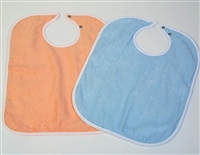
If you find that eating and drinking causes spillage onto your clothes, you may want to consider wearing an apron or bib. There is a large range of designs, some more discreet than others. They are available in disposable plastic or washable/wipeable materials. Consider what is the best fastening system for you, whether the bib/apron pulls over the head, is tied, has a Velcro hook and loop system, a popper, or some other way of fixing.
If you find the idea of wearing a bib difficult, you might like to consider wearing a standard cooking apron, although they are not generally waterproof and will need washing.
T-shirt bibs
A T-shirt bib tucks into the neck of a shirt/blouse, so looks like a tee shirt worn underneath. This would be most useful to a person who loses fluids from their mouth. It does not protect the clothes or lap from food spillages.
Bandana bibs
Bandana bibs are designed to look more like a scarf or bandana around the neck. The smaller ones will catch saliva or liquids lost from the mouth, but will be less useful for protecting clothes from food spillage. There are larger designs available that would be more protective.
Flat panel bibs
The most common bibs are flat panels which fit over the head or fix around the neck. They generally cover the whole of the front. Some are long enough to protect the lap when seated. They are wipe clean with a polyester surface or machine washable. Some bibs have an upturned bottom edge designed to catch crumbs and spills.
Disposable bibs
Disposable bibs and aprons are available to bulk buy. Made from thin plastic, they slip over the neck, or tie at the neck and behind the back. Some have small self-adhesive patches. If laundry is difficult, disposable bibs/aprons can be helpful.
Drinking Equipment
Cups with enlarged handles
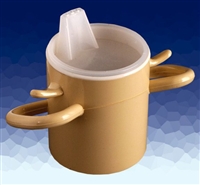
Cups with enlarged handles allow you to use your whole hand to grasp the handle, or you can put your fingers through the handle so that a tight grip is not necessary. When taking a hot drink, a cup made of a material that does not conduct heat as effectively (e.g., plastic rather than china) may be safer to handle if using this method.
Cups with two handles
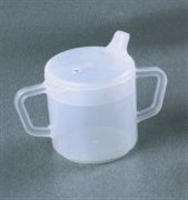
Cups with two handles allow the weight of the cup to be distributed evenly between two hands. The size and shape of the handles are important for enabling you to get a comfortable grip. Handles are often large to allow the use of all the fingers to grip the handle.
Cups with moulded or mouldable handles
Cups with moulded or mouldable handles give a more personalised grip, fitting the shape of your hand. Some cups are designed for comfort in mind, others have bendable handles and are modular so that they can be tailored to suit individual requirements. A personalised grip can be added to an existing cup using a mouldable resin.
Spill resistant cups and mugs
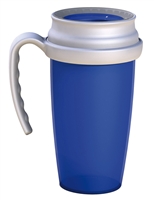
Spill resistant cups and mugs have features such as lids or a spill resistant insert, which may help prevent spillage.
Heavy or weighted cups
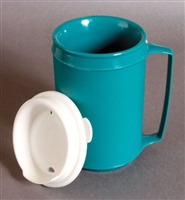
Heavy or weighted cups may help to reduce tremor as they require more effort to lift. This is due to their heavy weight.t, it may be sufficient to use a heavier china cup or mug.
Cups with lids and spouts

A cup with a lid can be used to prevent the contents spilling. Some cups have 'commuter' lids - a flat lid with a drinking hole which is fairly unobtrusive. Other cups have spouts, either perforated or with a drinking hole at the end. Some drinking holes are wide enough to accommodate a straw.
Cups with large spouts
A longer, wider spout will be easier for the user to form an effective seal around.
Water bottles with spouts
Water bottles with spouts are commonly available, often associated with sports. The spouts come in a range of designs which means you may have to try various ones before you find one that works best for you.
Anti-tremor device within the cup
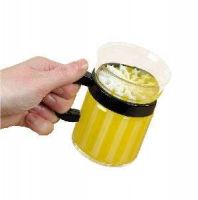
Some cups and mugs have anti-tremor inserts designed to reduce the risk of spilling if the cup is shaken. Inserts designed to reduce the risk of spilling if the cup is shaken.
Angled or cut-out cups
Cups with angled handles and/or a top edge that slopes away from front to back require
Insulated cups
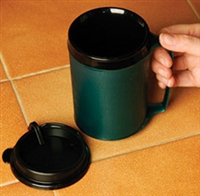
An insulated cup will enable the drinker to rest their second hand on the base of the cup to assist and steady the manoeuvre of raising the cup to the mouth.
Straws
A long straw can be used to completely avoid having to lift a cup or a mug. Some mugs come with their own lids with straws, and straw holders are available to make sure the straw stays in the right position.
Straws with integral one-way valves are also commonly available, meaning less effort is required.
Hydration packs
If you like to drink fluids throughout the day, you may find a runner’s backpack (hydration pack), a useful way of managing this. This has a water bladder in a slim pack which is carried close to your back. It has an integral straw which is sited close to the mouth. Some people find the water bladders and straws difficult to keep clean.
Brightly coloured cups
A cup or mug can be selected for its brightness or colour contrast from the table/environment it is to be used in. This will make it more easily identifiable from its surroundings for a person with sight loss. When filling a cup, if the colour of the cup contrasts with the colour of the liquid, the liquid level will be easier to see.
Patterned drinking glasses
A glass with a pattern on, rather than one that is completely transparent, will be easier to locate.
Vacuum cups
These cups have a valve in the lid which is operated by finger pressure, controlling the flow of liquid.
Narrow-top cups
This style of cup will help to reduce the amount of heat lost to the air directly above the drink, but it might be more difficult to drink from.
Drinking systems
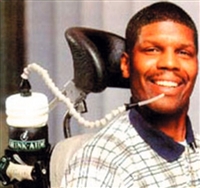
People who have minimal hand and arm movement, or who have difficulty controlling the amount of fluid drawn up into their mouths, may be very dependent on a carer for help. Consequently, they may no longer feel they are in control of when they can have a drink.
Special systems are available that give back a degree of independence by delivering the drink to the drinker via a straw that incorporates a non-return valve and/or a pump. All systems are free standing on a tabletop, and do not need to be lifted or tilted in any way by the user. These systems should only be obtained after assessment and recommendation by a speech and language therapist, as they are deemed to have potential for choking or causing discomfort for an untrained user.
Cutlery
Large grip cutlery
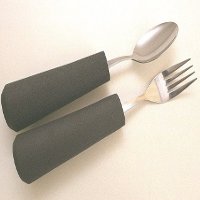
Large grip cutlery means that the user's fingers do not need to be wrapped tightly around the cutlery handle for a stable and secure hold.
Cutlery with moulded handles
Cutlery with moulded handles is shaped to fit the contours of the hand, giving a more comfortable, secure grip. Some moulded handles have a hilt to prevent the hand slipping forwards towards the cutlery head.
Cutlery that incorporates a hand strap
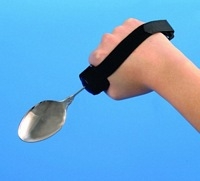
If maintaining a grip on the handle is a problem, a hand strap with a slot for the cutlery handle, d, will retain the cutlery in the hand.
Weighted cutlery
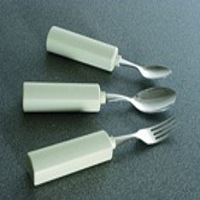
Weighted cutlery may be particularly helpful to people with tremors, as the extra weight can suppress unwanted movement. A weighted wrist cuff may produce the same effect.
Angled and swivel cutlery
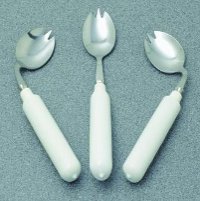
Angled and swivel cutlery either comes with a fixed angle on the cutlery head, or has a swivel joint between the head of the fork or spoon and the handle. This helps the head to stay horizontal despite uncontrolled movement. It is available for right and left-handed use.
Non-metallic or plastic-coated cutlery
Non-metallic or plastic-coated cutlery may prevent damage to the teeth if the diner has a strong bite reflex, or poor control when bringing the spoon up to the mouth.
Deep bowl spoons
Food may be retained better on the spoon if the bowl of the spoon is deep, although it may be more difficult to take food from the spoon. Some deep bowl spoons are specially shaped to make sipping from them easier.
Combination cutlery
Combination cutlery combines the features of two or more pieces of cutlery so that the user does not need to swap from a fork to a knife, for example, whilst eating. The cutlery may combine a knife edge and a fork, a spoon and a fork
Knives with rocker blades
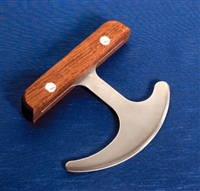
Knives with rocker blades cut food using a rocking action rather than the conventional way of drawing the knife forwards and backwards over the food (which requires a fork to stabilise the food). Some versions have horizontal handles, while others have a vertical handle.
Lightweight cutlery
Lightweight cutlery made of polypropylene or other lightweight material, may ease the effort of eating.
Plates, bowls and trays
Plate guards
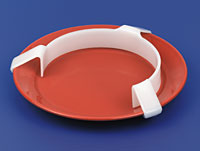
A plate guard, or plate surround, clips onto the edge of your chosen plate. They prevent food spillage and give you an edge against which to scoop up your food, if required. They are usually made of white or transparent plastic, although bright colours are also available. They may also be made of stainless steel.
Plates and bowls with high rims

Plates and bowls with high rims give a barrier that prevents food falling off the plate, and gives an edge to push food up against when loading a spoon or fork. Some versions are made of plastic, while others are ceramic.
Partitioned bowls and plates
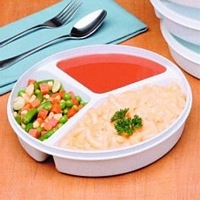
Partitioned bowls and plates have compartments to separate food, and which also provide walls to push food against to help pick it up. They may be preferred by users with sight loss to identify where different foods are placed on the plate.
Heavy crockery
Some ceramic plates are heavy and therefore more likely to stay in one position.
Unbreakable crockery
Unbreakable crockery may be more practical if breakages are commonplace, although many items are made of lightweight materials such as plastic, and are therefore more easily knocked out of position.
Anti-slip plates and bowls
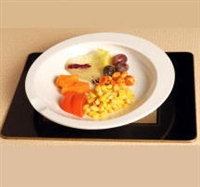
Anti-slip plates and bowls have an anti-slip or suction base to help maintain position on the table.
Slip-resistant mats
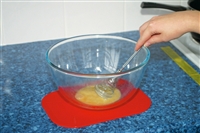
If the plate slides on the table surface, a slip-resistant mat can be placed between the plate and the table.
Insulated bowls
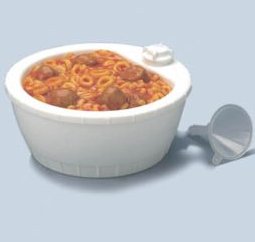
Insulated bowls may have a double-skinned wall to help retain heat. Others have a reservoir to take hot water to keep the plate warm.
Insulated trays
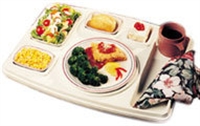
These trays have double walls and a recessed upper surface to take crockery.
Heated trays and mats
These incorporate a low voltage heating element to keep the food warm.
Eating systems
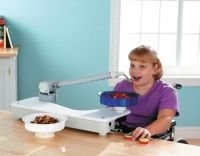
Eating systems deliver food to the diner's mouth via, for example, a rotating plate and a mechanical or electronically controlled spoon. Some systems are powered, while others are hand or foot operated.
People who have very little hand and arm movement, or who have poor control over their muscles, may be very dependent on a carer for feeding. There are systems available that give back a degree of independence to the disabled person, although if they are at risk of choking, someone should always be nearby. Equipment of this type is often expensive, and an assessment may well be necessary to determine which system best meets individual needs. Equipment that may be helpful includes:
Mobile arm supports
Mobile arm supports support the user's forearm in a trough-shaped device that tilts to bring the hand down and upwards. Some are also mounted on a swivel that glides in the horizontal plane, and powered versions will raise and lower the whole device.
Specialist advice on overcoming complex feeding difficulties is available from the Association for Rehabilitation of Communication and Oral Skills (ARCOS).
References
Alzheimer’s Society (2025). Eating and drinking. Available at: https://www.alzheimers.org.uk/get-support/daily-living/eating-drinking (Accessed: 10 February 2025).
Association for Rehabilitation of Communication and Oral Skills (ARCOS) (2025). Available at: arcos.org.uk (Accessed: 10 February 2025).
British Healthcare Trades Association (BHTA) (2025). Available at: https://www.bhta.com/ (Accessed: 10 February 2025).
GOV.UK (2014). Care Act 2014. Available at: https://www.legislation.gov.uk/ukpga/2014/23/contents/enacted/data.htm (Accessed: 10 February 2025).
GOV.UK (2025). Find your local council. Available at: https://www.gov.uk/find-local-council (Accessed: 10 February 2025).
RNIB (2025). Available at: https://www.rnib.org.uk/ (Accessed: 10 February 2025).